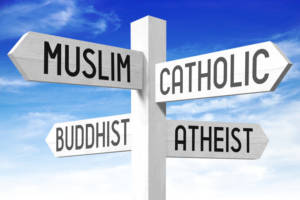Is Atheism on the Rise in Canada?
Statistics appear to show the number of Canadians who proclaim no religious affiliation, including atheism, may have increased during the last two decades.
The last two decades have brought gradual transformations to Canada’s religious landscape. Data tables from Statistics Canada appear to show that the number of Canadians who are irreligious, including adherents of atheism and humanism, may have increased during this period. Is atheism on the rise, as some sources in Canada purport? Comprehending the answer to that question requires a wider examination of recent shifts in religious beliefs within our country.
Counting Canada’s Atheist Population
As a 2013 Huffington Post article revealed, around 7.8 million Canadians disclosed on the 2011 National Household Survey (NHS) that they claimed no religious affiliation. That’s almost 24 percent of Canada’s population, and a significant increase from the 16.5 percent that claimed no religious affiliation in the 2001 survey. Notably, the NHS groups several belief systems under the “no religious affiliation” umbrella, including atheism, humanism and agnosticism, along with those who simply answered “no religion.”
Atheism on its own totaled almost 48,700 adherents, or nearly 0.15 percent of all Canadians surveyed for the 2011 version. According to Ontario Consultants on Religious Tolerance, around 18,600 declared themselves to be atheists on the 2001 edition and over 13,500 responded the same way on the 1991 survey. That would suggest a slow, steady increase over the last two decades, with their numbers more than doubling since 2001.
Are There Problems With the Numbers?
On the other hand, data from the 2011 National Household Survey has been scrutinized and criticized due to a lower-than-expected response rate. As CityLab contributor Aarian Marshall pointed out in a 2015 article, policy changes enacted in 2010 meant that response to the NHS became voluntary instead of mandatory. Only 69 percent of respondents sent back their long-form surveys, raising some serious questions about data precision in the 2011 edition as well as possibly the 2016 version. Moreover, concerns remain about accurate counts for underserved populations such as those living in poverty, immigrants, First Nations communities and people of color.
In the face of these possible trends and worries, questions arise concerning what the 2011 NHS numbers really mean. Meanwhile, the 2016 NHS’s census profile has been released on the Statistics Canada website, but the current data does not include information regarding respondents’ religious affiliation.
Understanding the Bigger Picture
With the absence of reliable numbers, journalists, theologians and scholars rely on other data sources and anecdotal testimonies to understand the larger picture of religion in Canada. A March 2015 Angus Reid Institute report revealed several key developments:
- An increase in the number of Canadians “inclined to reject religion”
- Dwindling numbers of those who “embraced religion”
- A sizable group of respondents who said they were “in between”
Nevertheless, these figures only tell part of the story. A 2015 CBC article explained that traditional Protestant Christian congregations are losing members while Catholic and evangelical churches, along with Muslim mosques and Sikh temples, are experiencing increases. Although misgivings remain about the 2011 NHS data, these observations are supported by its finding of sharp upswings in Sikh and Muslim populations between 2001 and 2011. Simultaneously, more Canadians may also be embracing Neopagan paths, African orisha-based religions or the First Nations spiritual practices of their ancestors, but it’s difficult to make any concrete guesses without solid data.
Faith in Canada: A Complex Picture
While there are serious doubts about the accuracy of NHS data on Canadian religious affiliations, some general observations can be derived from multiple sources. Atheism, humanism and agnosticism adherents in Canada may have grown within the last 20 years, but the overall picture of faith in our country is more multifaceted. With immigration causing shifts in membership and more people adopting non-Abrahamic spiritual paths, it’s important to remember that there are larger, more complex stories behind the data and headlines.
A Brief History of Religious Veiling
With current efforts to ban religious veiling in public, it is important to understand the history of this practice.
With several Western nations experiencing increases in Muslim immigration, one major issue rising to the surface is religious veiling. Depending on the type of Islam they practice and the countries from which they originate, Muslim women might opt for simple headscarves, veiling that obscures their heads and shoulders, or complete body coverings. Current public discourse has sometimes resulted in legislation to ban religious veiling in public. Against the backdrop of such fevered discussions, it’s important to understand Islam is not the only faith in which people wear veils. In fact, the origins of religious veiling can prove to be rather surprising.
Religious Veiling in the Ancient Middle East
Racked contributor Liana Aghajanian revealed in a December 2016 piece that women all over the world have been wearing some form of head covering for more than 3,000 years. For instance, the practice was common throughout the ancient Levant region as well as Greece, Rome and regions located in modern-day Turkey, Iran and Iraq. Rather than signifying any devotion to religious piety, they originally denoted that the women who wore them belonged to these societies’ upper classes. Aghajanian discloses the discovery of a 13th-century Assyrian text forbidding anyone other than aristocrats from donning veils. Working class women, slaves and other lower-class individuals faced legally prescribed punishments if they were caught wearing them.
Head Covering and Religion in the Modern Era
It isn’t immediately clear how head coverings became associated with religious modesty, but they were eventually adopted by women of all socioeconomic classes throughout the Middle East. Traditions from the three major Abrahamic faiths soon dictated that veils should be worn. The University of North Carolina’s Center for European Studies explains that some Jewish people interpret their faith’s “tzniuth,” or laws on modesty, to mean that women’s hair should be covered. While the Bible’s New Testament records no commandments issued by Jesus Christ concerning the issue, Saint Paul upheld the practice in his first letter to the Corinthian church.
Meanwhile, various sects of Islam actually disagree over religious veiling. CNN writer Abed Awad disclosed in a June 2015 write-up that the Quran never explicitly mentions the word “veil.” Additionally, there are two general schools of thought on the matter resulting from different interpretations of customs said to be handed from Aisha, one of Muhammed’s wives:
Veil everything except for the hands, feet and face upon reaching puberty.
It’s a good idea to wear veils, but they are not obligatory.
Bill 62: The Latest in Veil Legislation
Recent Canadian news includes reports about Quebec’s Bill 62, which initially required the province’s residents to show their faces to provide or receive any sort of public services. The Globe and Mail clarified in December 2017 that this law, which would have impacted aspects of daily life such as riding public transit and visiting libraries, was temporarily put on hold by the province’s Superior Court. The Quebec law is certainly not the first of its kind. The Guardian revealed in March 2017 that Europe has an almost decade-long history full of repeated attempts to regulate the practice of religious veiling, and debates over the issue rage on south of our border. While advocates of these regulations cite public security worries, pushback ensues based on concerns about religious discrimination as well as the safety of women who opt to cover their heads. Muslims also hold views on both sides of the issue, with some opining that such bans are fueled by Islamophobia while others support measures to outlaw face covering.
Several factors prove that the issue of religious veiling in public isn’t as cut and dry as one might be tempted to believe. Religion, personal freedom, public safety and concerns about racial and religious discrimination all play into the larger discussion. Since Statistics Canada predicts that the number of Muslims will significantly increase by the year 2036, public debate may continue for some years to come.
Why Does Canada Still Have a Blasphemy Law? The killings at the Paris office of the satirical magazine Charlie Hebdo on January 15 has once again brought the issue of free speech front and center. Should there be limits to what is off-limits? Canadian media coverage in the days since the incident seems to largely portray a collective sentiment (with a few exceptions) in overwhelming support of free speech, no matter how offensive it may be to some. Canadian politicians vehemently condemned the killings and a number of media outlets showed the cartoons on TV and in print. However, this response does seem a little ironic since blasphemy is still technically illegal in Canada.
The killings at the Paris office of the satirical magazine Charlie Hebdo on January 15 has once again brought the issue of free speech front and center. Should there be limits to what is off-limits? Canadian media coverage in the days since the incident seems to largely portray a collective sentiment (with a few exceptions) in overwhelming support of free speech, no matter how offensive it may be to some. Canadian politicians vehemently condemned the killings and a number of media outlets showed the cartoons on TV and in print. However, this response does seem a little ironic since blasphemy is still technically illegal in Canada.
Section 296 of the Criminal Code of Canada
Per Section 296 of the Criminal Code of Canada, publishing blasphemous libel is an indictable offence and if convicted you can go to prison for up to two years. Anyone accused is permitted to defend himself or herself of the charge provided they use “decent language.”
- (1) Everyone who publishes a blasphemous libel is guilty of an indictable offence and liable to imprisonment for a term not exceeding two years.
(2) It is a question of fact whether or not any matter that is published is a blasphemous libel.
(3) No person shall be convicted of an offence under this section for expressing in good faith and in decent language, or attempting to establish by argument used in good faith and conveyed in decent language, an opinion on a religious subject.
Definition of Blasphemy
There is a good chance many Canadians don’t know what blasphemy means and have no idea blasphemous libel is a criminal offense in their country. For those who would like a little clarity on the definition, it is “the act or offense of speaking sacrilegiously about God or sacred things; profane talk.” These days it is hard to miss all the blasphemy out there; from TV shows, movies, newspapers to video games, it is on full display.
History
The language outlawing blasphemy was first included in the Canadian Criminal Code in 1892. There have been a handful of times in the last century when Canadians have been accused of blasphemous libel.
- 1927: Eugene Starry, a Toronto atheist, was sent to jail for 60 days after a being accused of insulting Christianity. He was ultimately deported to England where he had been born.
- 1977: A poet who wrote about a gay Jesus Christ was charged, but not convicted.
- 1980: Owners of a theater in Sault Ste. Marie were accused, but not convicted, after screening Life of Brian (a Monty Python movie), which is a spoof on Christ. An Anglican vicar who had seen the film had complained to local authorities.
The Pope Weighs In
Pope Francis unequivocally condemned the Paris attacks and said there was no way to justify them in God’s name. He said free speech was a fundamental right and it is the duty of people to speak their mind for the common good. However, the Pope also stated there are limits and a reaction of some kind when people make fun of the religious beliefs of others is not unexpected.
Other Blasphemy Laws
There are many countries that still have blasphemy laws and, in some cases, punishment for the crime is death. It is not particularly surprising that Afghanistan, Iran and Saudi Arabia have them, but it is that Ireland and Australia do as well. In 2008, the United Kingdom repealed its blasphemy law. In the United States, there are no federal blasphemy laws since they would violate the U.S. Constitution.
It seems more than strange in this day and age that a progressive western country like Canada would still have a blasphemy law, even if it has fallen out of use. Yet, it’s still there.
Radical Islam: A detriment to the world. Radical Islam has been controversial for many decades, but has gotten more media attention during the last ten years due in part to their attacks on the Western world. Islam is a complex and multifaceted religion that encompasses many groups, which means that Radical Islam is as far removed from mainstream Islam as the Crusades were to modern Christianity. Radical Islam is, therefore, not only a threat to the modern world, but it’s also a threat to modern Islam and its members.
Radical Islam has been controversial for many decades, but has gotten more media attention during the last ten years due in part to their attacks on the Western world. Islam is a complex and multifaceted religion that encompasses many groups, which means that Radical Islam is as far removed from mainstream Islam as the Crusades were to modern Christianity. Radical Islam is, therefore, not only a threat to the modern world, but it’s also a threat to modern Islam and its members.
This fervent behavior conflicts with the beliefs of the Universal Life Church because of the harm that it does directly to its members and to the rest of the world as well. The ULC believes in doing what is right, and not only does Radical Islam conflict with this message, it also conflicts with many of the messages of traditional Islam as well.
Radical Islam has led to many terrorist sects that are seeking to destroy Western ways. Western society is seen as financially and sexually decadent, and members of Radical Islam believe that jihad is necessary for the rest of the world to see the light. However, most mainstream Muslims would explain that though “jihad” does mean war, it’s usually used in a figurative sense, and not a literal sense. Radical Muslims, however, have taken this war literally and intend to fight it.
Much like Radical Christianity and Radical Judaism, Radical Islam strips many rights away from women. All of these religions originated in extremely sexist times, which means that when radicals attempt to return to the roots of their origins, they bring back outdated belief systems. Within Radical Islamic countries, female genital mutilation still exists and is still practiced. Female genital mutilation is not comparable to circumcision, and the sufferers of these mutilations will never have normal lives. The only purpose to female genital mutilation is to make sure that women will never have pleasure during sex, thereby lessening the chances they may cheat on their men or become sexually active on their own.
In Radical Islamic countries, women are still not allowed to show their skin, and they are not allowed to have men that are not their family in their home or to travel without men with them. In these radical countries, elderly women have been flogged to death simply for having young men in their home delivering groceries. Girls are forbidden from pursuing higher education, and many of them enter arranged marriages at a young age without any recourse.
It’s important to recognize, as the Universal Life Church does, that most Muslims are not Radical Muslims, and that the beliefs of Radical Islam in no way reflect the beliefs of the majority of Islam. Radical Islam is mostly seen in the Middle East nations, whereas most Muslims today are actually located in Southeast Asian countries such as Malaysia. While ULC believes that Radical Islamic believes are inappropriate because they promote the harm of individuals both within their group and outside of their group, this does not necessarily imply anything about ULC’s beliefs about mainstream Islam.





 Radical Islam has been controversial for many decades, but has gotten more media attention during the last ten years due in part to their attacks on the Western world. Islam is a complex and multifaceted religion that encompasses many groups, which means that Radical Islam is as far removed from mainstream Islam as the Crusades were to modern Christianity. Radical Islam is, therefore, not only a threat to the modern world, but it’s also a threat to modern Islam and its members.
Radical Islam has been controversial for many decades, but has gotten more media attention during the last ten years due in part to their attacks on the Western world. Islam is a complex and multifaceted religion that encompasses many groups, which means that Radical Islam is as far removed from mainstream Islam as the Crusades were to modern Christianity. Radical Islam is, therefore, not only a threat to the modern world, but it’s also a threat to modern Islam and its members.